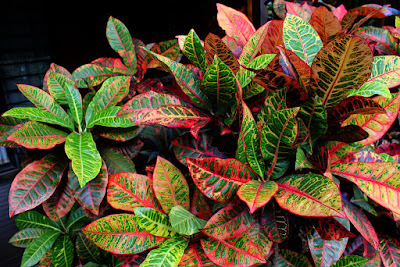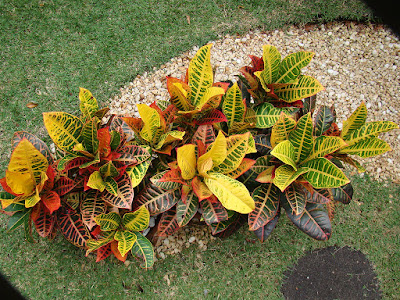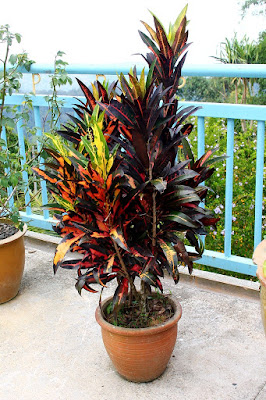Codiaeum variegatum, also called as Croton plant, fire croton, garden croton, or variegated croton, Croton variegatum, is a species in the genus Codiaeum. In southeastern Asia they have been cultivated for centuries and many hundreds of cultivars have been bred with a range of different leaf shapes, sizes and colors.
Codiaeum variegatum, also called as Croton plant, fire croton, garden croton, or variegated croton, Croton variegatum, is a species in the genus Codiaeum. In southeastern Asia they have been cultivated for centuries and many hundreds of cultivars have been bred with a range of different leaf shapes, sizes and colors.
IDENTIFY CROTON PLANT - CODIAEUM VARIEGATUM
Codiaeum variegatum are originally native to Indonesia, Papua New Guinea, the Philippines and northern Queensland, Australia, growing in open forests and scrub.
It is a tropical, evergreen, monoecious shrub growing to 9.8 ft. tall. Most croton cultivars grow 5-7 feet tall. Some of the smaller leafed cultivars stay shorter. There are also some larger crotons that can grow taller, up to 10 to 15 feet. As previously mentioned hundreds of cultivars have been developed with a wide range of leaf sizes, shapes and colors. Leaves can be marked with shades of green, yellow, orange, red, pink, purple, maroon, and white.
Garden croton is well-suited to use as a foundation, accent, specimen, or container planting. There are fine examples of Croton used as a hedge but this much color in a landscape is sometimes overpowering to the senses.
Some of the available cultivars offering a wide variety of leaf color and shape include:
- ‘AFD 5’ (leaves are green with yellow veins fading to red as they mature).
- ‘Andreanum’ (broad yellow leaves).
- ‘Angustissimum’ (narrow leaves with yellow margins and ribs).
- ‘Aucubifolium’ (broad yellow, red-blotched leaves).
- ‘Aureo Maculatum’ (also known as ‘Gold Dust’, smaller green leaves with yellow spotting).
- ‘Corkscrew’ (narrow green leaves with yellow markings and are twisted).
- ‘Dreadlocks’ (narrow, twisted and hanging leaves that are green and yellow turning red and maroon).
- ‘Eburneum’ (puckered leaves with cream markings).
- ‘Eleanor Roosevelt’ (narrow green leaves with yellow spots).
- ‘Franklin Roosevelt’ (narrow leaves with red, orange, yellow, green, and maroon coloring).
- ‘General Paget’ (very large leaves that are green and yellow, a larger growing variety).
- ‘Interruptum’ (sometimes twisted, yellow leaves with red midrib).
- ‘Magnificent’ (large leaves marked with green, yellow, red, pink, and maroon).
- ‘Mammey’ (narrow, twisted leaves that are mostly a bright orange and red but with some green and yellow, very common).
- ‘Mother and Daughter’ (unusual narrow leaves that are green on top and maroon underneath, the leaf appears to be connected to a second leaf by a midrib).
- ‘Mrs. Iceton’ (new leaves emerge green and yellow and mature to maroon and pink, this one likes light shade).
- ‘Petra’ (large, green and yellow leaves turning orange and red as they mature, currently the most widely available variety).
- ‘Picasso’s Paintbrush’ (very narrow, slender leaves colored green, yellow, orange, red, and maroon).
- ‘Pinocchio’ (smaller orange and red leaves with orange, yellow and green spots).
- ‘Purity’ (large green leaves with white or light yellow markings, a larger growing variety).
- ‘Rudy Bachman’ (large green leaves with yellow spots and veins turning orange and red).
- ‘Sanderi’ (broad leaves, irregularly blotched).
- ‘Spirale’ (red and green spirally-twisted leaves).
- ‘Sunny Star’ (narrow, short green leaves with yellow markings).
- ‘Weismannii’ (narrow, wavy-margined leaves, variegated with yellow, red petiole).
- ‘Zanzibar’ (narrow and drooping leaves colored green, yellow, orange, and red).
CROTON PLANT - CODIAEUM VARIEGATUM CARE AND CULTURE
Cultural information should only be used as a guide, and should be to be adapted to suit you. Your physical location; where you grow your plants, how much time you have to devote to their care, and many other factors, will need to be taken into account. Only then can you decide on the cultural methods that best suit you and your plants.
Light:
Crotons are easy to grow. Most prefer full sun or bright shade. Plants in higher light have the brighter coloring. Some varieties prefer indirect sun and will look washed out with full sun. Crotons can tolerate shade but the shadier the location the less vivid the foliage color will be.
Temperature:
Night time temperatures should be about 65°F and a daytime temperature range of 70°-80°F, with 80°F being ideal. Plant it in a warm location in the landscape. They only survive outdoors where temperatures do not normally drop below 10° to 13 °C in winter; colder temperatures can cause leaf loss. In colder locations be prepared to protect the shrub in winter or grow in containers and bring them indoors during freezing weather. Frost or temperatures below freezing temperatures can damage crotons.
Humidity:
Codiaeum variegatum require high humidity (near 70%). Unfortunately, when temperatures in the home rise above 67°F, the humidity drops drastically, so it may be necessary to sacrifice a few degrees of warmth in lieu of an increase in the humidity. Additional humidity can be created by setting the planter on a tray filled with moist pebbles, creating an indoor greenhouse or placing an aquarium nearby.
Substrate and growing media:
Crotons grow best in fertile soil that is moist but well drained. It is recommend structurally stable, peat-free compost. The addition of expanded clay or lava rock granules improves the permeability. Repot your Croton in early spring.
Watering:
In full sun they need regular irrigation during dry periods but in shadier locations can handle some drought. Keep the soil evenly moist except in December and January when you should allow the soil to dry slightly to allow for dormancy.
Fertilizer:
Feed Crotons monthly when they are actively growing with a fertilizer specifically formulated for house plants. It is important to ensure that you do not apply the product to a dried soil, but water before a little bit with clear water. Don't fertilize the plant in the rest period from October to February.
Pruning:
Please keep in mind the toxicity of the plant juice and carry out the work with safety gloves. Crotons can tolerate pruning to be kept smaller but not shearing. Leggy plants can be pruned back to encourage bushier growth in spring and summer. Do not cut out the withered leaves. As soon as croton has absorbed the nutrient residues it contains, it releases a dead leaf, so that it is easily plucked off.
Propagation:
Crotons are easily propagated with tip cuttings taken from new growth in the spring or summer and rooted at 70°-80°F. Croton plants can also be propagated by air layering. Start Croton seeds indoors at any time of the year. Maintain a temperature of 75°-80°F within the growing medium until germination, which takes about 30 days.















COMMENTS